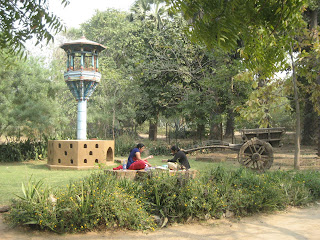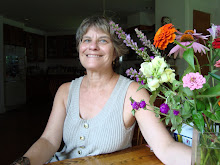



For our second day in Ahmedabad (Friday), we decided to go to a museum in the morning and in the afternoon to the Gandhi ashram, a spiritual community Gandhi created in 1915 to live in, when he came back to India at age 46 after many years of practicing law and being an activist in South Africa. From several appealing museum choices in Lonely Planet, we selected a folk art museum on the edge of town, which turned out to be an inspired pick, because it had amazingly beautiful textiles of all sorts and embroidered, beaded, and decorated clothing that was out of this world, as well as other lovely objects. Unfortunately, no photographs were allowed inside, so I can't share the beauty, but if you are ever in Ahmedabad, don't miss it!
To get there, we had to take an auto-rickshaw, and the driver of the first one that pulled up in answer to our signal seemed sufficiently unclear about where we were going that we decided to pass on him and wait for another. At that moment, one directly across the street from us did a daring U-turn right through traffic and came alongside us -- a reckless (but completely typical) maneuver that might have made us hesitate, except that the driver turned out to be an "old friend" from the night before -- someone who had helped us get across the street when we were engulfed by the traffic and crowd from the holiday! He not only took us out to the museum, but ended up waiting for us for almost two hours there and then taking us out to the Gandhi ashram, showing us a good place to have lunch, and waiting for us again before finally taking us back to our hotel (his photo is above). All this, basically a whole day's work, for, I'm embarrassed to admit, less than $10 -- and that's with a generous tip over what he actually charged. This tells you something about wages (I'm guessing that was more than what he would have made in an average day's normal driving, or he wouldn't have chosen to do it) and it also tells you something about our privilege -- which it is easy to be reminded of every day here, not just from the inexpensive prices, but from the much less luxurious way that even middle-class people live.
The gorgeous folk art museum is on the grounds of a large campus called the Shreyas Children's Educational, Cultural, and Social Welfare Centre that was established in 1947 by a wealthy Indian couple, Manorama and Leena Sarabhai. The grounds, which are large and beautiful, contain a children's school, a home for neglected or abandoned children, a physical education centre, an art centre with music, dance, drama, and art studios, and several theatres, as well as the folk museum, a children's museum of toys, a camp ground, and a deer park. It is like a huge green oasis on the outskirts of the city, and it seemed like it would be a fabulous place to go to school, especially since there is a tremendous emphasis on the arts, as you could tell from a photo exhibit of the children's work that was in a room adjoining the museum. When I got a pamphlet about it, it turned out to my surprise that the first supervising teacher was Maria Montessori, who has always been somewhat of a heroine of mine. Some quick Internet research revealed that she was forced to leave Italy by Mussolini because of her refusal to conduct her school in a manner acceptable to fascism (i.e., militaristically), and went to India in 1939, where she stayed for the duration of the war and developed many refinements of her educational method, including apparently during her work at Shreyas. Montessori education remains popular in India to this day.
The Gandhi ashram, about 5 km north of the center of the city overlooking the Sabarmati River, was very moving, because of the simplicity of the grounds and few buildings, including the room in which Gandhi himself lived (see photo), because of an excellent museum with photos of his life and actual documents he had written (such as a letter to Adolf Hitler urging him not to continue his push toward war), and especially, for me, because of a large placard on the side of the main building containing Gandhi's rules for the ashram in his handwriting, as well as in Gujurati, Hindi, and English (see photo). Because reading them made such an impression on me, I'm tempted to type them all right into this blog, but because it's a fairly long document, instead I'll give a website where you can find them all -- http://www.gandhiashram.org.in/index.php?option=com_content&task=view&id=24&Itemid=45 -- and limit my quoting to a few favorites:
Non-violence
Mere not-killing is not enough. The active part of non-violence is Love. The law of Love requires equal consideration for all life from the tiniest insect to the highest man. One who follows this law must not be angry even with the perpetrator of the greatest imaginable wrong, but must love him, wish him well and serve him. Although he must thus love the wrong doer, he must never submit to his wrong or his injustice, but must oppose it with all his might, and must patiently and without resentment suffer all the hardships to which the wrong doer may subject him in punishment for his opposition.
Non-Stealing
It is not enough not to take another's property without his permission. . . . It is also theft if one receives anything which he does not really need. The fine truth at the bottom of this principle is that Nature provides just enough, and no more, for our daily need. Hence it is also a theft to possess anything more than one's minimum requirement.
Non-possession or Poverty
This principle is really a part of the previous one. Just as one must not receive, so must one not possess anything which one des not really need. It would be a breach of this principle to possess unnecessary foodstuffs, clothing or furniture. For instance, one must not keep a chair if one can do without it. In observing this principle one is led to a progressive simplification of one's own life.
I don't have much hope, or even intention, of reaching any of these goals, but there was something very affecting about contemplating them. And so ended our second day in the big city. We had tea and something to eat, went back to our hotel to meet our car and driver, and left from there -- getting back to our apartment on campus at about 10 p.m. I even knew my way around Anand well enough that I could help the driver find the campus from downtown -- that showed me that I'm really getting to be at home!



No comments:
Post a Comment